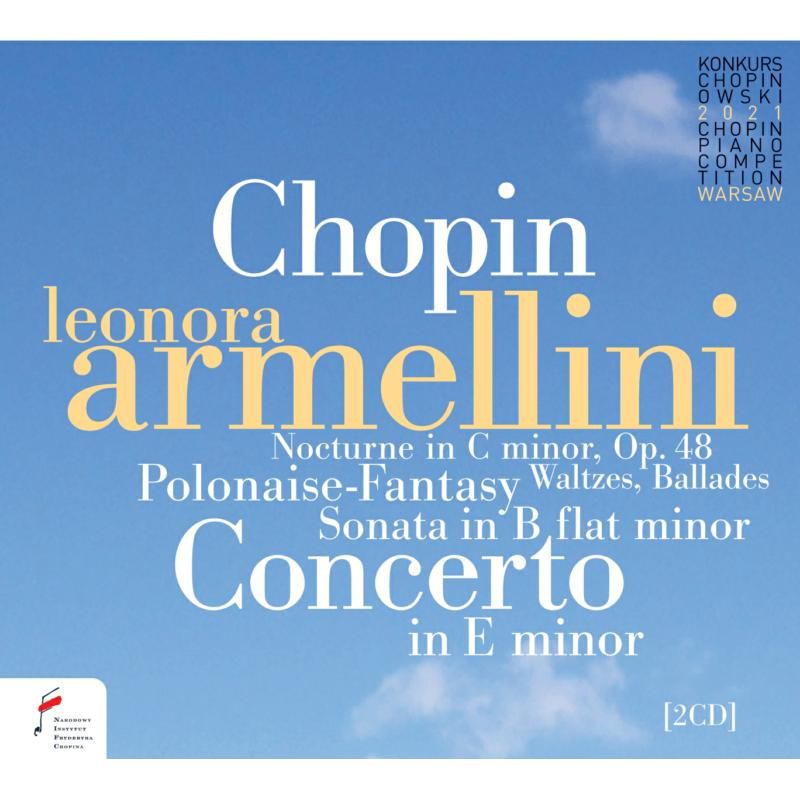Chopin from Warsaw: meeting Leonora Armellini

Pianist Leonora Armellini was born in Padua, Italy, beginning lessons aged four with Laura Palmieri (a Michelangeli pupil); later, she moved to the Accademia Nazionale di Santa Cecilia, graduating aged 17. Lilya Silberstein at Hamburg was another prime influence. Prior to this Chopin Competition, Armellini was a finalist in the XVI Busoni compsetition in Bolzano, Italy (in 2017).
Chopin’s C-Minor Nocturne (Op. 48/1) is an interesting piece because of the storminess of the central section; There is an inherent danger that the pianist leaves the world of a Nocturne and suddenly we find ourselves in a wind-swept Scherzo! Armellini treads this fine line perfectly: there is passion galore (and clarity) in that central panel. Thsi was from the first stage, and so the video is available:
The performances on the disc are unedited - they are documents of the competition after all, not finished products in the traditional sense - so the odd blemish is par for the course. Good to hear Armellini’s lyricism in the spotlight for the Etude, Op. 25/5 (E-Minor) - how the melody sings with a Bellini-like cantabile, and how the texture that surrounds it is delivered with a different, lighter and most beautiful touch:
Personally, I find that performance more convincing than her available recording, released on the Continuo label in 2017 (click for link to that performance).
In contrast, Armellini’s C sharp-Minor Etude from the Op. 10 set scintillates, with no compromises for speed. This is the performance from the First Round:
The E-Major Scherzo, again from the First Round, confirms why Armellini had no problems progressing in the competition: variegated, but with full structural understanding:
It is often the way in these competitions that we meet lesser-known compositions, and such is the case here with Chopin’s Sostenuto (Waltz) in E flat, a piece unpulished until 1955. An autograph score exists dating from 1840; it acts as someting of a waltz-prelude to the much more famous A flat Waltz, Op. 34/1, performed with glittering aplomb by Armellini. Let's hear the two one after the other to get the right effect (we're in the competition's second stage now, by the way):
Armellini plays on a Fazioli, and the choice is a fine one: the brightness enables true textural clarity, against a firm bass. We hear that clarity again in the A flat Ballade (Op. 47:, heard right next to the F-Minor Ballade, (Op. 52), the latter in a performance of heartbreaking pathos and remarkable understanding of this utterly unique piece (and, technically, listen to the evenness of the inner-voice trills):
Similarly, while there is much to recommend Armellini's A flat Polonaise, Op. 53 from the Second Round, it is the more elusice Polonaise-Fantaisie, Op. 61 (a later composition from 1846) that truly enchants. Armellini finds huge beauty, dares to give the harmonies space but never loses the listener:
The second disc presents performances from the third round and the final. A poignant set of Mazurkas begins, that of Op 41 (composed 1838/9). Listen to Armellini’s considered way with the first (E-Minor):
The slightly obsessive second (B-Major) cedes to the more fluid third (A flat) before Armelllini presents the enigmatic final C sharp-Minor perfectly. Here’s that second Mazurka:
In Armellini”s hands, and in the context of the CD playing order, that set of Mazurkas is far more than a preludial warm-in to the great Second Sonata (B flat-Minor, Op. 35. It is true Armellini”s interpretation of the sonata is a work-in-progress and that here are some slips, but bonus points for not only including the repeat but repeating right back to the Grave - one of Chopin”s most arresting gestures, stopping the music in mid-flow. Another aspect of this is her awareness of Chopin’s linear counterpoint (Chopin”s hero was Bach, after all!). The Scherzo just avoids a sense of “stuttering” in its repeated notes; the Trio offers a place of balm. Yet ultimately, I find the Mazurkas more satisfying - everything is present and correct but Armellini is yet to prenetrate ot the Sonata’s heart. Ther eis beauty but not a Heavenly shaft of light in teh contrasting melody in the “Marche funèbre”; instead one marvels at the beauty of the bed of sound of the left-hand, perfrctly judged. The finale scampers malevolently - Cortot’s wind amongst the gravestones - no mere exercise this, and performed with laudably little pedal. Here's the complete performance:
And finally, the Concerto finale, in which Armellini was joined by the Warsaw Philharmonic Orchestra under Andrzej Boreyko. The first movement is spacious and considered. The orchestra provides much fire when it gets the chance (! - Chopin”s writing for orchestra is somewhat notorious), but be aware this is a competition recording and some of the orchestra; textures tend to crowd.
The Romance is a dream, though, just under ten minutes of Chopin at his flowing, most heart-felt greatest. Armellini dares to let the music speak naturally, and slowly - argiably she sits on the cusp of Larghetto and Largo. I like the orchsetra’s brusque way with the finale”s opening, but I like Armellini’s touch far more: encapsulating a jeu perlé in her runs, persenting the theme so freshly it is as if she is improvising. No wonder the audience applause is immediate and enthusiastic;
Armellini is streets ahead of the orchestra here, the latter slightly scrappy at times, set against the joy one gleans from Armellini”s awareness of voicing, her variety of touch and tone and her harmonic awareness.
Leonore Armellini won the Fifth Prize at the XVIII Chopin Competiion, but her pervasive sense of lyricism, her awarenss of texture and counterpoint coupled with a fine structural awareness bring her to, at least, my attention. She is certainly a pianist I would like to hear live.
